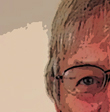| |
And while on SOFII read about the adventures of new trustee Warren, in What makes an effective board
part 1.
part 2.
|
|
The police officer was puzzled. The women driver appeared to be quite annoyed about the fact that he’d pulled her over. Yet there were three children in the back of the car, and none was wearing a seat belt.
‘Why,’ asked the officer, in his most tolerant voice, ‘are these children not wearing seat belts?’
The woman’s indignation mounted, visibly. ‘Well,’ she responded huffily, ‘they’re not my children...’
The point is, people often do strange things, for no good reason. So trying to understand and anticipate them is often a complete waste of time.
The exception, of course, is fundraisers. They generally play safe, always seeking to have a tried and tested reason that will justify everything. So they are much easier to understand and anticipate. And much more boring. Perhaps, though, that matters less than the possibility that they may also be much less successful than they could be.
Take that client of fundraising sage Bernard Ross*, who wanted the obviously much cleverer than he Bernard to come up with ‘a startling piece of innovation’.
When Bernard duly unveiled the product of his flair for innovative thinking the quite satisfied client responded with, ‘Fine, Bernard, brilliant in fact. But how do I know it will work? Have you got anyone who’s actually tried it?’
These short tales illustrate two kinds of stupidity. The blinkered kind and the cautious kind. Both are endemic in our profession.
Emotionally at least I feel sure it’s preferable to be a reckless failure than a cautious or blinkered success. But I’m in the minority here. Thankfully, there is something far better than both. This is the entrepreneurial risk-taking change-maker, someone who isn’t reckless but takes her or his time and does things properly. In this piece I want to pay tribute to one of these and draw out a few useful lessons from his initiatives.
We all know that if you want to succeed big time you have to take risks. Fortune favours the brave, no guts, no glory, and all that. Well, that’s what we all say, even though what we mostly do is a different matter.
Not for all of us. Some fundraisers, even in these cautious times, have creative risk-taking hard wired into their DNA.
One of these is a man who goes by the unusual name of Giles Pegram. He’s recently retired from the position he’s held these last 30 plus years as director of appeals at the NSPCC, one of Britain’s most loved and respected top fundraising charities.
You’d think that anyone who’s been in the same job for 30 years must be in something of a comfortable rut. But not Giles Pegram. If you assume this then you’ve obviously not heard of the famous NSPCC Centenary Appeal (see opposite), or of its equally striking but even more ambitious and more recent counterpart, the NSPCC Full Stop Appeal.
Both of these mega-appeals are featured in some detail on SOFII (well, the Centenary Appeal is there and the Full Stop campaign will be soon) so I won’t repeat them here. You can and should read them in full as they contain more potential lessons than most fundraisers will learn in a lifetime, for how to change your organisation for the better. In this piece I’ll simply explain why I think we should all view Giles Pegram as a role model worth emulating. If we could be even a bit like him, voluntary activity would be transformed very quickly into something many times more powerful, more important and more effective than it is now.
Why? Because Giles Pegram specifically set out to turn everything on its head, not once, but twice.
Causing one major transformation could smack of opportunism or even luck. To do it twice suggests deliberate, determined perversity of the most calculated but constructive kind. Giles needed to completely change the culture of his organisation, so he set about securing a mandate to do so from the very highest authorities in the NSPCC. He surrounded himself with an array of appropriate professionals both internal and external. He encouraged the NSPCC to completely rethink the scale of its ambitions and to gear up for nothing less than the defeat of child abuse.
Starting four full years before the anticipated launch of his first transformational campaign he then set the biggest, most ambitious targets that he and his close adviser Redmond Mullin could reasonably conceive. And he secured the essential investment for doing it. Then, slowly and painstakingly, they put in place the most formidable fundraising machine that the UK has ever seen.
In attempting and achieving these things Giles Pegram showed several specific qualities that sadly are in short supply these days.
- He took his time. He would not be rushed. He did his homework.
- He aimed high. When one of his trustees baulked at his very ambitious target, suggesting a much lower sum because it would be more surely achievable, his response was to say, ‘Yes, if we aim for £5 million we
will get it, whereas if we aim for £12 million we may fail and only raise £8 million. But which is better, a £5 million success, or an £8 million failure?’
- He and Redmond thought it all through. To the smallest detail, nothing was overlooked. The Centenary Appeal is a textbook case.
- He used fundraising ambition and potential to encourage his child care colleagues to significantly raise their sights, bringing dramatic and radical change to the work that NSPCC does for children.
- He invested in training, becoming one of the first and most effective advocates of fundraising training in the UK.
- He involved everybody and devolved power effectively to an extraordinary network of volunteer and professional fundraisers.
- He then stretched everyone, to make the achievement just as big as it possibly could be. He sustained the momentum not just to the target but through the subsequent consolidation phases too.
Most extraordinary of all perhaps is that, having gone through the pain and exhilaration of doing this once, he then went and did it all again, only on a bigger scale.
Yet, amazingly, like the lady in the car at the start of this story, they aren’t his children either! Sometimes, there is a point in being irrational.
In wishing Giles Pegram a long and happy retirement I can’t help but say that I hope he doesn’t go too far away or get too used to a quiet life. For I expect that those who might aspire to be similarly entrepreneurial – and I’m sure that there must be some out there – could well have good reason to call upon him for guidance, in years to come.
© Ken Burnett 2010.
*See The Zen of Fundraising, page 129
|
|
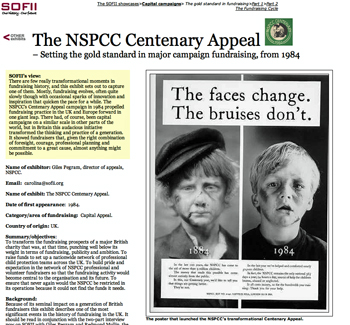 Visit SOFII Visit SOFII
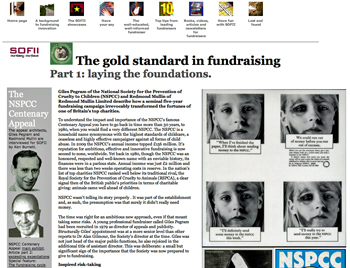 Visit SOFII Visit SOFII
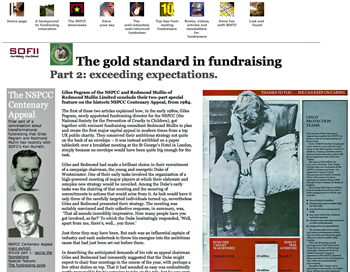 Visit SOFII Visit SOFII
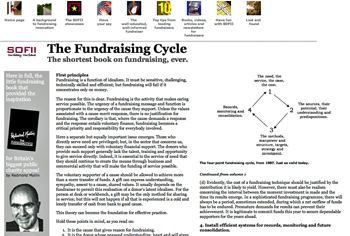 Visit SOFII Visit SOFII
Click the link at the side to visit the exhibit or article on SOFII.
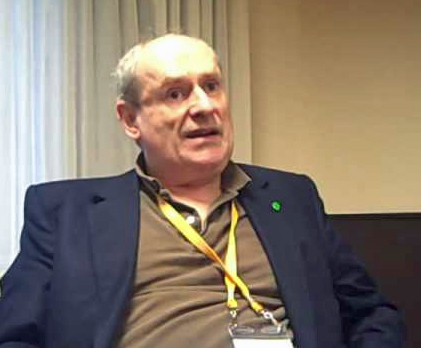
I’ve already apologised for singling him out for embarassing praise, but he’s retiring now, so what can he do? Giles Pegram now, as retirement beckons.
*Footnote. In the 2010 New Year’s honours list Giles Pegram was recognised with the award of a CBE, Commander of the Order of the British Empire. Who says fundraisers don’t get the recognition they deserve?
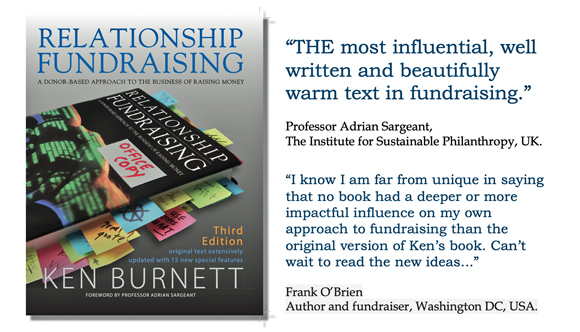
Ken Burnett’s books on fundraising and communication include the classic Relationship Fundraising: a donor-based approach to the business of raising money, Friends for Life: relationship fundraising in practice and The Zen of Fundraising. To fill the gaps in your library, click here.
|
